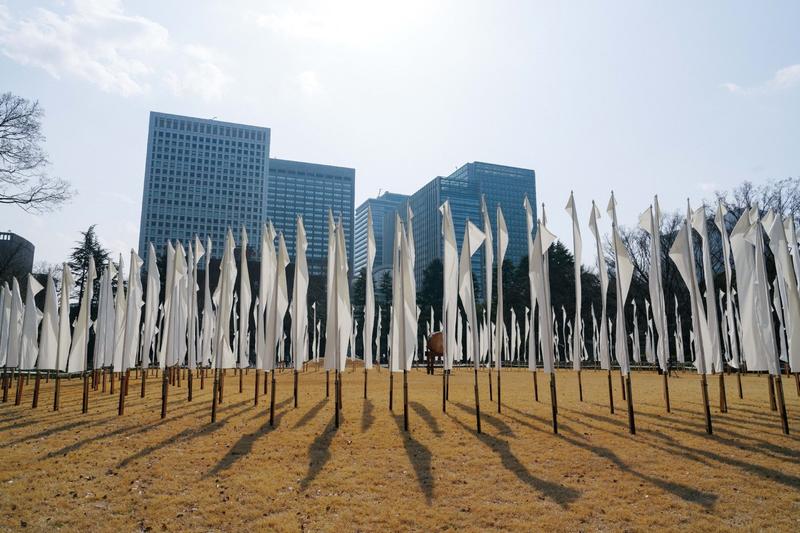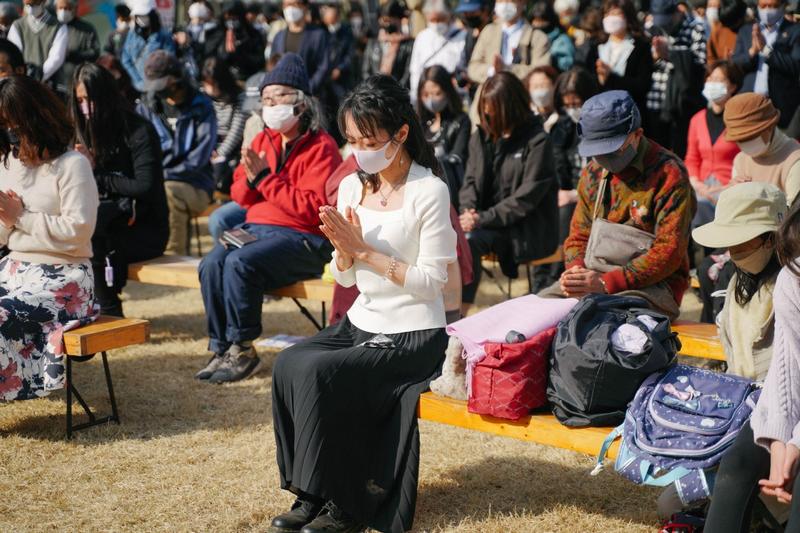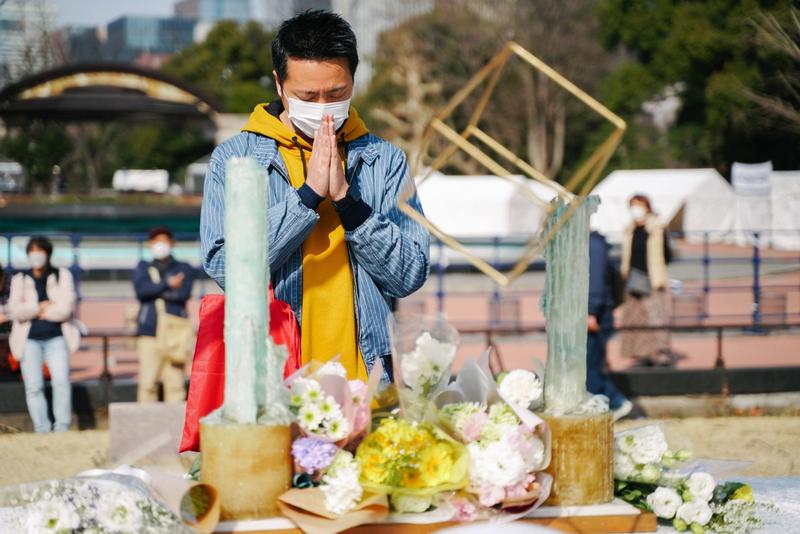 A woman prays in front of a temporary altar at the Hibiya Park in Tokyo, Japan, on March 11, 2022 to commemorate the victims of a magnitude-9.0 earthquake and ensuing tsunami that hit Japan's northeast on March 11, 2011. (PHOTO / XINHUA)
A woman prays in front of a temporary altar at the Hibiya Park in Tokyo, Japan, on March 11, 2022 to commemorate the victims of a magnitude-9.0 earthquake and ensuing tsunami that hit Japan's northeast on March 11, 2011. (PHOTO / XINHUA)
On March 11, 2011, Japan recorded its biggest earthquake ever. The magnitude 9.0 earthquake off the north-eastern coast was followed by a deadly 40-meter tsunami that sent a wall of water crashing through ports and coastal regions, washing away everything in its path and killing more than 20,000 people.
As tragic as the earthquake and tsunami was, nothing prepared Japan or the world for the meltdown of three nuclear reactors at the Fukushima Daiichi Nuclear Power Plant that was built on the coast and was hit by the tsunami.
It triggered a nuclear disaster not seen since the Chernobyl disaster on April 26, 1986, when there was an accident at the number four reactor largely originated from improper design and operation.
In Fukushima's case, it was the product of nature – an earthquake followed by a tsunami. But the cost has been enormous.
 A total of 311 flags are set at the Hibiya Park in Tokyo, Japan, on March 11, 2022 to commemorate the victims of a magnitude-9.0 earthquake and ensuing tsunami that hit Japan's northeast on March 11, 2011. (PHOTO / XINHUA)
A total of 311 flags are set at the Hibiya Park in Tokyo, Japan, on March 11, 2022 to commemorate the victims of a magnitude-9.0 earthquake and ensuing tsunami that hit Japan's northeast on March 11, 2011. (PHOTO / XINHUA)
The government has put the cost of decommissioning the four reactors at 8 trillion yen ($68.5 billion); but the Japan Center for Economic Research, a think tank, estimates the bill could be much more. Some estimates put the cleanup bill as high as $1 trillion
The plant owner, Tokyo Electric Power Co, has said it could take another 30 years to retrieve undamaged fuel, remove resolidified melted fuel debris, disassemble the reactors, and dispose of contaminated cooling water.
The government has put the cost of decommissioning the four reactors at 8 trillion yen ($68.5 billion); but the Japan Center for Economic Research, a think tank, estimates the bill could be much more. Some estimates put the cleanup bill as high as $1 trillion.
Nearly 165,000 residents were evacuated from Fukushima and surrounding suburbs, but most have been allowed to return after a decade of decontamination. It is estimated that less than 30,000 do not intend to return.
ALSO READ: Japan's top court orders TEPCO to pay Fukushima victims
As the cleanup continues, questions remain. And one major question – what to do with the one million tonnes of radioactive wastewater, now stored in 1,000 tanks on the site, which was used to cool the reactors.
The Japanese government would like to release the water into the Pacific Ocean, but this has caused a great deal of concern to the island nations scattered across the Pacific as well as some other Asian countries.
 People observe a moment of silence at 2:46 pm local time in the Hibiya Park in Tokyo, Japan, on March 11, 2022 to commemorate the victims of a magnitude-9.0 earthquake and ensuing tsunami that hit Japan's northeast on March 11, 2011. (PHOTO / XINHUA)
People observe a moment of silence at 2:46 pm local time in the Hibiya Park in Tokyo, Japan, on March 11, 2022 to commemorate the victims of a magnitude-9.0 earthquake and ensuing tsunami that hit Japan's northeast on March 11, 2011. (PHOTO / XINHUA)
The International Atomic Energy Agency set up a task force last year to oversee proper disposal of the wastewater. The task force consists of staff members from across various departments and laboratories of the IAEA, and 11 internationally recognized experts with diverse backgrounds from Argentina, Australia, Canada, China, France, the Marshall Islands, the Republic of Korea, the Russian Federation, the United Kingdom, the United States and Vietnam.
The Japanese government would like to release the water into the Pacific Ocean, but this has caused a great deal of concern to the island nations scattered across the Pacific as well as some other Asian countries
Professor Brendan Kennedy, from the School of Chemistry at the University of Sydney, said the water used to cool the reactors has an excess of tritium, a radioactive form of hydrogen. "Tritium is all around us, but now we have an excess. The question is what to do with it," Kennedy said.
Associate professor Nigel Marks of the physics and astronomy department at Curtin University, Western Australia, said eleven years after the disaster, the reactors at Fukushima are still being cooled down.
ALSO READ: Japan, IAEA discuss Fukushima water plan amid opposition
"And this will continue for many years to come. A vast number of large storage tanks have been built on the site, but space is rapidly running out," Marks said.
"This is why the Japanese govt announced last year that treated wastewater would be released into the ocean."
He said the vast majority of toxic elements could have been removed from the wastewater.
"But one element remains – tritium, a mildly radioactive form of hydrogen that is impossible to separate from water on an industrial scale," Marks said.
According to the IAEA, nuclear energy had been a strategic priority in Japan since the 1960s, supplying almost a third of the country's electricity. The Fukushima disaster put an end to Japan's nuclear energy program.
 A man prays in front of a temporary altar at the Hibiya Park in Tokyo, Japan, on March 11, 2022 to commemorate the victims of a magnitude-9.0 earthquake and ensuing tsunami that hit Japan's northeast on March 11, 2011. (PHOTO / XINHUA)
A man prays in front of a temporary altar at the Hibiya Park in Tokyo, Japan, on March 11, 2022 to commemorate the victims of a magnitude-9.0 earthquake and ensuing tsunami that hit Japan's northeast on March 11, 2011. (PHOTO / XINHUA)
But one element remains – tritium, a mildly radioactive form of hydrogen that is impossible to separate from water on an industrial scale
Nigel Marks, associate professor of the physics and astronomy department at Curtin University, Western Australia
Today, less than five percent of Japan's electricity is provided by nine nuclear power plants that remain operational. These plants too will be phased out.
The IAEA classified Fukushima as a "Level 7" nuclear accident, which means it had widespread health and environmental impacts.
There have only been two "Level 7" accidents in history. The first was at Chernobyl, often referred to as the world's worst nuclear accident.
READ MORE: Japan's Tepco hit by setback in clean-up of Fukushima plant
The accidents at both Chernobyl and Fukushima have also drawn comparisons to the accident at Three Mile Island nuclear power plant, in the US. It was a "level 5" nuclear accident that took place on March 28, 1979.
Chernobyl had a higher death toll than Fukushima.
Within three months of the disaster, more than 30 people had died from acute radiation sickness. Today, scientists estimate that tens, perhaps even hundreds, of thousands of people were severely affected by the catastrophe.
The accident at Fukushima was not quite as devastating. Although it did not directly kill anyone, it did result in about 1,600 stress-related deaths.


